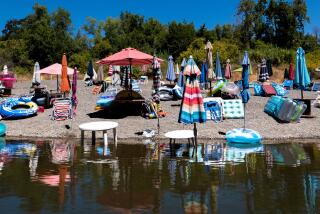The Rumors You’ve Heard About Negril Are True
- Share via
NEGRIL, Jamaica — The first thing to put to rest is the matter of drugs and nudity. Is it true what they say about Negril? That drugs are rampant, that marijuana is smoked in cigarettes the size of Havana cigars, that the rough wooden signs advertising “mushroom tea” refer to something considerably more potent than a health-food brew?
Is it true that the small scalloped beaches harbor females as naked as the day they were born and that the local youths who paddle their dugout canoes into these coves have something else on their minds than selling coral?
Is it really true that Negril is a final refuge for those aging flower children who were physically unable to make the transition from yippie to yuppie?
Or is it all an overblown myth, a cynical hype, a press agent’s fiction invented to lure the gullible tourist to this island instead of one of the dozens of others?
It is all true.
It Started on a Whim
I first visited Negril on a whim. Waiting at the Montego Bay airport for a plane to New York, I saw a long-haired young man with a scraggly beard and ragged shorts--nothing more. Something told me he was going to the beach on the western tip of Jamaica that was sometimes mentioned as an afterthought by travel agents who had booked previous vacations to the island.
I approached timidly and asked. He was going there, and in the friendliest fashion offered me a lift and his services in finding one of the rooms that he assured me were plentifully available in native shacks.
I demurred, but something stirred in me and instead of taking my flight home, I impulsively hopped a propeller-driven shuttle, and 45 minutes later was walking barefoot, luggage in hand, on a miles-long beach with palm trees on my left and the Caribbean on my right.
Not far from the airport were two attractive beach-front hotels, but I felt somehow, that they weren’t for me. Beyond stretched untouched sand and vegetation, broken here and there by tiny wooden houses tucked among the trees.
Hotels and Huts
I walked several miles, leisurely, carelessly, sensing that this was going to be all right. I saw other hotels, not large, a few clusters of huts, and I stopped along the way, looking for the one that was waiting for me.
Behind a large sign a white frame house sat back near the road, while on the beach was a two-story structure made of tree trunks and branches, a sort of island log cabin. I passed it, then doubled back.
At the house a gentle young woman showed me rooms to let and then led me to the hut where I found a small square space with a bed, a table and a kerosene lamp. Down a path was a shower and toilet. Ten paces in the other direction was the sea.
It was $5. I took it.
That night I sat on a chair at the edge of the water. I saw, far away along the beach, occasional fires and house lights, scarcely brighter than stars in the pitch-black sky. The breeze was just above cool, not quite warm, and pushed at me softly.
There was nowhere to go, utterly nothing to do. I was the loneliest man in the world.
Bland Vegetarian Stew
Next morning I walked the beach until I met a woman carrying a basket from which she sold me fresh-baked banana bread, and oranges to wash it down. At lunch some dreadnoughted Rastafarians supplied me with a bland vegetarian stew they were cooking in a pot over a driftwood fire.
The rest of the day I explored, modestly. There was not much to see, and besides, my program precluded any untoward expenditure of energy. I stayed as long as I could, I think it was three days, and went home.
I’ve returned several times since that first visit. I’ve stayed at the Silver Sands where the showers sometimes worked, at the T-Water before it exploded in size, at the Sundowner in a room overlooking an immense bougainvillea that blazed with color, the waking sight every glorious day.
I have eaten in the Tree House where the food is dreadful. I have eaten at outdoor barbecues where old Jamaican women broil chicken and ribs and the food is dreadful. And I have eaten at the Coral Cove, a beautiful stuccoed hotel set in a gorgeous grove of palms and eucalyptus trees. The food was dreadful.
And still I come back.
Sun and Germans
It is not for the drugs; drugs are not my scene. It is not the nudity, although I certainly don’t object. I once joined a charming European family, parents, grandparents and children, in a cross-cultural seaside conversation. Yards of skin, including mine. Besides, wherever there are sun and Germans, there is nudity, and there are sun and Germans everywhere.
It is something else, special to Negril, that exerts this pull: a laid-back ease, a luxurious torpor that seeps into your bones and stops the clock until before you know it, you feel as if you’ve been hit with a velvet mallet. There may be some who manage a fairly high level of energy but they are few, and they are assuredly not Jamaican.
Negril is divided into two parts. The town of the same name, a dusty collection of houses and stores, of wooden huts selling fruit and vegetables and expendable items of straw, sits smack in the middle, with the beach on one side and the cliffs on the other.
The cliffs are made of coral and rise sharply out of the sea, which rolls into little bays that capture and hold it like cups of emerald tea. Paths lead to the edge and stairs to the water and swimmers dive for a bottom that appears deceptively near.
Scattered along the cliffs are here a restaurant, there a hotel, the most elaborate the Cliff House, a group of conical huts with rudimentary furnishings placed with no apparent plan among the rocks.
A Contented Daze
On the other side of the road that parallels the sea are native shacks, some of which rent rooms at low rates to itinerant cliff dwellers who can be seen at any hour wandering aimlessly in a contented daze. Others have enclosed small spaces and called them restaurants and serve slapdash meals when and if the spirit moves.
A restaurant on the cliff, just before the lighthouse, claims to be famous. It is called Rick’s Cafe and it sells T-shirts with its name and Negril emblazoned on the front and I’ve never seen one anywhere but there.
Rick’s provides dinner, which is dreadful, but the main attraction is a large oval bar looking out to sea, and that plus the hard-selling of the Jamaican sunset as cause for celebration draws hordes of young (and not so) vacationers to late afternoon soirees that linger until the wee hours. Day after day, as the sun flips faithfully behind the horizon, it is as crowded and noisy as any Manhattan singles bar.
After the initial shock of physical beauty, the cliffs become static, restrictive. There is nowhere to roam except on the single dirt road, lined with breeze-denying trees that make it a broiling vacuum that can convert you to dust before your time. I am not crazy about the cliffs.
Stroll on the Beach
The beach is another matter. The beach is for walking. The sand is soft except at the water’s edge, where it is just right for strolling and it stretches as far as the eye can see.
The water is your stereotypical cerulean blue and warm and shallow a good distance out and gentle enough to encourage floating lazily under the sun. Somewhere toward the horizon is a coral reef and it is possible to persuade a boatman to take you there and show you to the fish.
There is a wide variety of tourist accommodations on the beach, some as might be expected in a Caribbean resort, others decidedly not. The brochure of the Negril Beach Club displays a healthy female torso in a wet T-shirt and says, “Dress informal (if at all)!” Day and night, the club rings with Teutonic gusto. It is Heidelberg by the Sea.
Right next door is the White Hall Cottage owned by Eulick Brown. It has three double rooms and two baths and the very same beach and no brochure at all.
In the mid-range of tourist digs are the cottage colonies--Tamboo, Yellowbird Seatel, White Sands and Crystal Waters, where a Jamaican woman will prepare fresh lobster in your own kitchen while you loll on the porch and study the waves.
Hedonism for Guests
At the beach’s northern extremity is Hedonism II where guests are herded in acquiescent droves and amused according to a predetermined schedule of sports and games and parties, and many seem to love it.
The beach is broken by rocky outcroppings and the resultant sandy scallops are nude beaches where city dwellers enthusiastically expose their previously private parts.
Interspersed among these officially sanctioned hostels are the houses of genuine Jamaicans. For a modest fee they will often permit the remnants of hippiedom to pitch tents in their backyards or rent rooms and huts with such names as Ozzie’s Shack and Cosmo’s, accommodations without electricity or internal plumbing, but perfect for escapees from a too-insistent civilization.
Indolent Insouciance
These are the places that set the style for which Negril is known. These and the encampments of members of the Rastafarian sect who cook their stews and smoke their dope and listen to reggae on Sanyos and Toshibas. It is this indolent insouciance that the larger operations try to bottle and sell and succeed in spite of themselves because it is the real thing.
The Negril beach takes visitors and residents alike, from the fairest fair to the blackest black and shakes them into an amiable mix. It only asks that you go with the flow, set your dial to the rhythm of the waves and leave the cares of the world to someone else.
It requires a certain metabolic shift that may take time to achieve, but in Negril, time is what there is plenty of. As the Jamaicans say, with a knowing smile, “Take-i-teasy, mon. It soon come.”
More to Read
Sign up for The Wild
We’ll help you find the best places to hike, bike and run, as well as the perfect silent spots for meditation and yoga.
You may occasionally receive promotional content from the Los Angeles Times.






